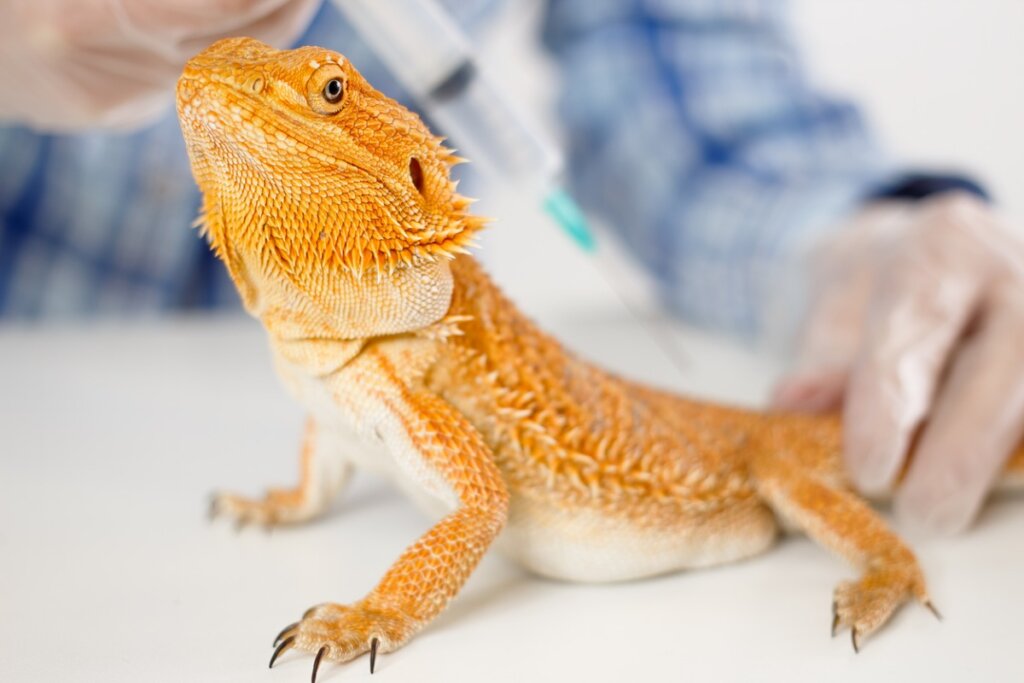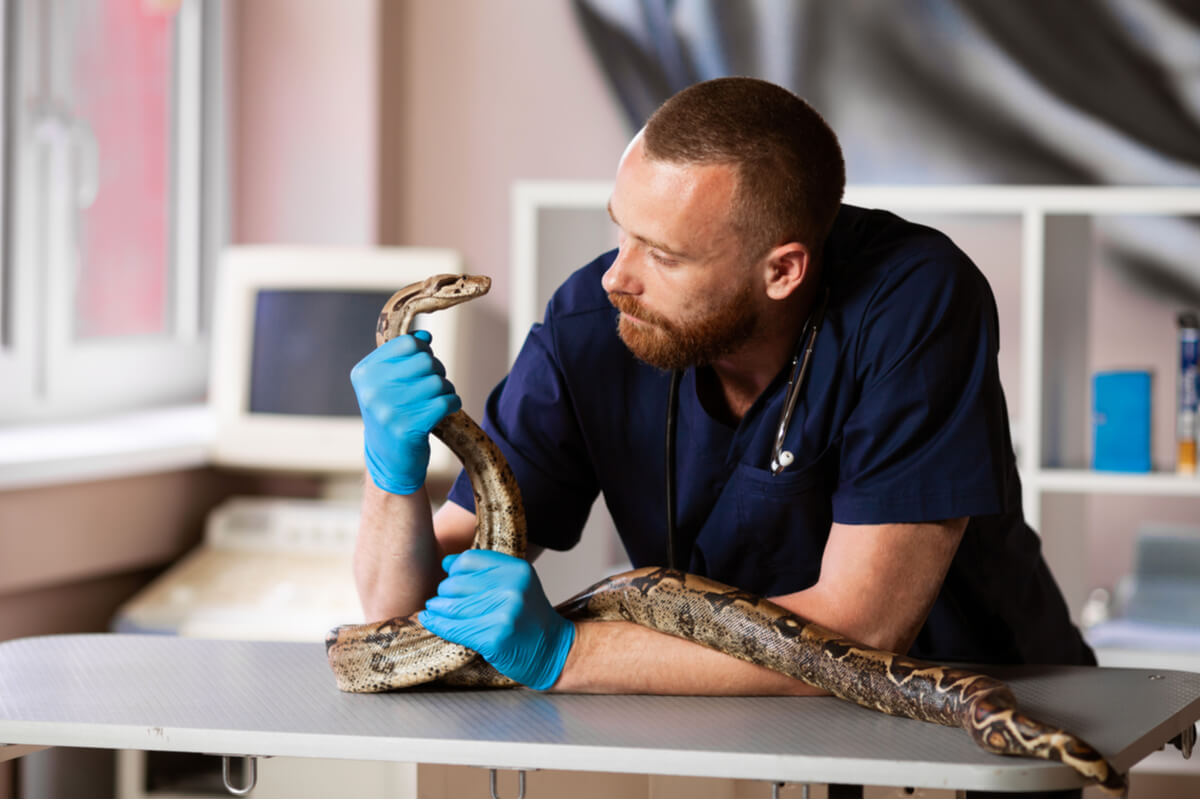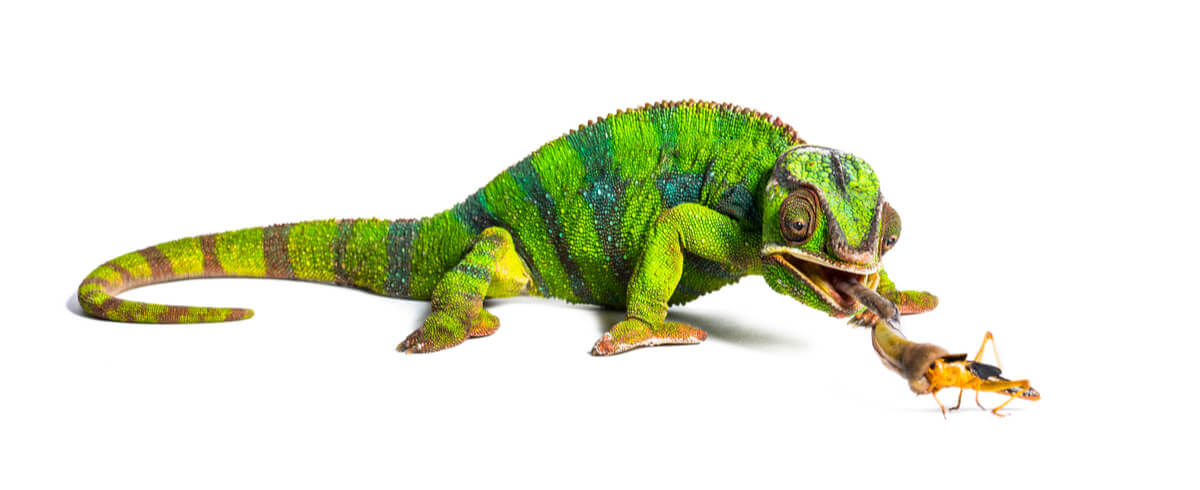Cloacal Prolapse in Reptiles: Symptoms and Treatment

Exotic pets are increasingly making their way into homes. Various reptiles such as chameleons, bearded dragons, leopard geckos, turtles, and snakes are nowadays bred in captivity and can be purchased in specialized shops at a reasonable price. However, it shouldn’t be forgotten that, as beautiful as they are, these animals are quite delicate in general. In this article, we’ll look at cloacal prolapse in reptiles.
Various physiological conditions can affect exotic animals if they don’t receive adequate care, and cloacal prolapse in reptiles is one of the most concerning from an aesthetic point of view. Although it isn’t a very serious or common condition, it can cause a scare for an inexperienced owner. Read on to find out more.
What is cloacal prolapse?
The cloaca of reptiles is a cavity located at the end of the digestive tract and open to the outside of the body. Its functions are multiple, because, apart from the excretion of feces, this area communicates directly with the urinary and reproductive systems. It’s also essential for urination and fertilization. Some chelonians are even able to breathe through it.
On a practical level, the cloaca is defined as an indentation under the reptile’s tail. All reptiles have a cloaca, but larger species (such as iguanas, bearded dragons, or adult chameleons) have a slightly more visible cloaca. Sometimes it’s a differential character between males and females, because the structures that form it and the accessory glands can be larger or smaller depending on the sex.
The term prolapse refers to the displacement of any organ out of its natural anatomical position. Thus, it’s easy to conclude that cloacal prolapse is the outgrowth of the tissues that make up this structure beyond their normal placement. The cloacal muscles are visible in the affected animal when they shouldn’t be protruding.
Cloacal prolapse is the protusion of the cloacal tissue out of the animal’s body.

Causes of cloacal prolapse in reptiles
The causes of cloacal prolapse in reptiles are usually a tightness or tenesmus (constantly straining to defecate) in the excretory area of the reptile, due to infection, inflammation, or physical trauma. In addition, it can have secondary origins caused by poor owner care. Take a look at the following list of errors.
- Low humidity levels: Low humidity in the terrarium causes the animal to dehydrate more easily if it’s tropical, which can lead to physiological imbalances, fecal impactions, and cloacal prolapse.
- Poor conditions in the terrarium: Too low temperatures, lack of thermal gradient, lack of hiding places, and size of the installation, for example. All this can cause stress and muscle tightness in the animal (including the perianal area).
- Malnutrition: A lack of calcium can lead to reduced intestinal function, which in turn leads to intestinal transit disorders and possible prolapse.
- Impaction: A reptile with inadequate substrate will eventually ingest some of it when trying to hunt prey. If the sand or stones are very fine, the animal won’t be able to spit them out and they’ll accumulate in its intestinal tract. This causes the formation of a plug that prevents it from defecating.
- Associated diseases: Malignant tumors, bacterial infections, and various inflammatory diseases can lead to cloacal prolapse in domestic reptiles.
- Failure to give birth: Oviduct prolapse is relatively common in female reptiles that have problems expelling eggs.
In addition to these causes, other possible triggers of prolapse include bladder stones, smegma plugs in the penis, metabolic bone disease, and many more. In short, it’s a multifactorial condition.
Symptoms
Symptoms of cloacal prolapse in reptiles are extremely easy to discern, as the affected animal will have a “flap” or pink tissue coming out from under the tail when it has never been there before. The keeper may also notice a little blood on the terrarium substrate, as the prolapsed area will rub against it and become slightly injured.
The reptile may also show other signs associated with the disease that’s causing the prolapse, such as a malformed tail (metabolic disorders), lack of fecal excretion (impaction), conjunctivitis (infection), and low body temperature. All of these symptoms warrant an emergency visit to an exotic animal veterinarian, so don’t ignore it.
Diagnosis
Detecting cloacal prolapse in reptiles is very simple, as everted tissue under the tail is a very obvious sign. However, the real diagnostic challenge lies in finding out which structure is affected and why it’s displaced from its natural place.
Sometimes a physical examination of the animal is sufficient, but, in other cases, it isn’t so clear-cut. For example, it may be necessary to use X-ray techniques in order to detect a metabolic disease, a tumor, or a congenital malformation. Analysis of the reptile’s feces will help to rule out possible infectious pathologies.
Treatment of cloacal prolapse in reptiles
This condition is a veterinary emergency in all cases and treatment should begin as soon as possible. Some of the approaches chosen by professionals are as follows:
- Keeping the prolapsed tissue moist: The area should be prevented from drying out, as the structures involved may die at a cellular level and cease to function. It’s recommended to apply lubricating solutions dissolved in water.
- Attempt to return the tissue to its natural area: After cleaning, the veterinary expert will try to gently and manually push the tissue back into place. If it’s inflamed, special ointments can be used to reduce the edema.
- Amputate the necrotic tissue: Before pushing the tissue back into place, any dead areas should be removed, as they encourage infections to develop in the animal.
- Suture both sides of the cloaca: It may be necessary to make the cloacal opening smaller in order to prevent the tissue from slipping back out of its normal area.
Depending on the cause of the prolapse, long-term treatment will vary in its aggressiveness. However, the generic application of certain drugs (such as non-steroidal anti-inflammatory drugs) is usually recommended to reduce symptomatology in almost all cases.

The prognosis of cloacal prolapse in reptiles depends entirely on the underlying causes. An environmental humidity imbalance resolves quickly, but a malignant tumor is difficult to address in such a small animal. Discuss with your veterinarian about the best course of action in each case.
All cited sources were thoroughly reviewed by our team to ensure their quality, reliability, currency, and validity. The bibliography of this article was considered reliable and of academic or scientific accuracy.
- Understanding prolapse in reptiles, Lafeber VET. Recogido a 26 de octubre en https://lafeber.com/vet/presenting-problem-prolapse-in-reptiles/
- Cloacal Prolapse Occurs in any Reptile Species, Veterinary Partner. Recogido a 26 de octubre en https://veterinarypartner.vin.com/default.aspx?pid=19239&catId=102919&id=7996764
